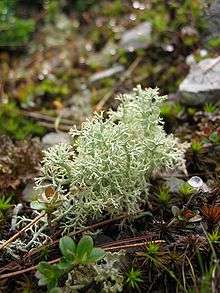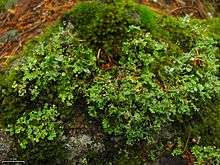Cladonia
Cladonia is a genus of moss-like lichens in the family Cladoniaceae. They are the primary food source for reindeer/caribou. Cladonia species are of economic importance to reindeer-herders, such as the Sami in Scandinavia or the Nenets in Russia. Antibiotic compounds are extracted from some species to create antibiotic cream. The light green species Cladonia stellaris is used in flower decorations.
| Cladonia | |
|---|---|
 | |
| Cladonia portentosa | |
| Scientific classification | |
| Kingdom: | |
| Division: | |
| Class: | |
| Order: | |
| Family: | |
| Genus: | Cladonia P.Browne |
| Type species | |
| Cladonia subulata (L.) Weber ex F.H.Wigg. | |
| Species | |
|
See text | |
Although the phylogeny of the genus Cladonia is still under investigation, two main morphological groups are commonly differentiated by taxonomists: the Cladonia morpho-type and the Cladina morpho-type. The Cladonia morpho-type has many more species, and is generally described as a group of squamulose (grow from squamules), cup-bearing lichens. The Cladina morpho-types are often referred to as forage lichens, mat-forming lichens, or reindeer lichens (due to their importance as caribou winter forage).
Cladonia perforata ("perforate cladonia") is one of two on the U.S. Endangered Species List, and it should never be collected. It exists only in a few small populations in Florida.
Several Cladonia species grow on sand dunes. The presence, and luxuriant carpet-like growth, of Cladonia species is one of the defining characters of grey dune, a priority habitat for conservation under the E.U. Habitats Directive.
Cladonia species are used as food plants by the larvae of some Lepidoptera species including Chionodes continuella.
Selected species
Listed alphabetically.[1] See below for complete list of species.
- Cladonia amaurocraea – Quill Lichen
- Cladonia apodocarpa
- Cladonia asahinae – Pixie Cup Lichen
- Cladonia borealis – Boreal Cup Lichen
- Cladonia caespiticia
- Cladonia cardiosa – Split-leg Lichen
- Cladonia cenotea – Powdered Funnel Lichen
- Cladonia chlorophaea – Mealy Pixie Cup
- Cladonia coniocraea – Common Powderhorn
- Cladonia convoluta
- Cladonia cristatella – British Soldiers Lichen
- Cladonia deformis – Lesser Sulphur-cup Lichen
- Cladonia fimbriana – Trumpet Lichen
- Cladonia gracilis – Smooth Horn Lichen
- Cladonia grayi
- Cladonia macilenta – Lipstick Powderhorn
- Cladonia macrophyllodes – Large-leaved Cladonia
- Cladonia mitis – Green Reindeer Lichen or Yellow Reindeer Lichen
- Cladonia mongkolsukii
- Cladonia multiformis – Sieve Lichen
- Cladonia parasitica
- Cladonia peziziformis – Cup Lichen
- Cladonia phyllophora – Felt Horn Lichen
- Cladonia pleurota – Red-fruited Pixie Cup
- Cladonia portentosa – Reindeer Lichen
- Cladonia pyxidata – Pebbled Pixie Lichen
- Cladonia rangiferina – Grey Reindeer Lichen or True Reindeer Lichen
- Cladonia rei – Wand Lichen
- Cladonia squamosa – Dragon Horn
- Cladonia stellaris – Northern Reindeer Lichen or Star-tipped Reindeer Lichen
- Cladonia subcariosa
- Cladonia subtenuis
- Cladonia subulata
- Cladonia turgida – Crazy Scale Lichen
- Cladonia uncialis – Thorn Lichen
- Cladonia verticillata – Ladder Lichen
Gallery
.jpg) Cladonia apodocarpa
Cladonia apodocarpa.jpg) Cladonia caespiticia
Cladonia caespiticia.jpg) Cladonia coniocraea – Common powderhorn
Cladonia coniocraea – Common powderhorn Cladonia convoluta
Cladonia convoluta Cladonia cristatella – British soldiers
Cladonia cristatella – British soldiers- Cladonia macilenta var. bacillaris – Lipstick Cladonia
 Cladonia macrophyllodes – Large-leaved cladonia
Cladonia macrophyllodes – Large-leaved cladonia.jpg) Cladonia grayi complex
Cladonia grayi complex.jpg)
.jpg) Cladonia peziziformis
Cladonia peziziformis.jpg) Cladonia pleurota – Red-fruited pixie cup
Cladonia pleurota – Red-fruited pixie cup.jpg) Cladonia subcariosa (Syns.: C. sobolescens, C. calvulifera)
Cladonia subcariosa (Syns.: C. sobolescens, C. calvulifera).jpg) Cladonia subtenuis
Cladonia subtenuis
See also
Further references
Anderson, R. (2009). Cladonia peziziformis (With.) J.R. Laundon (Lecanorales: Cladoniaceae) re-discovered in Co. Down. Ir. Nat. J. 30: 146.
References
- Walewski. Joe (2007). Lichens of the North Woods. Duluth, MN: Kollath+Stensaas Publ.
External links
| Wikimedia Commons has media related to Cladonia. |
| Wikispecies has information related to Cladonia |